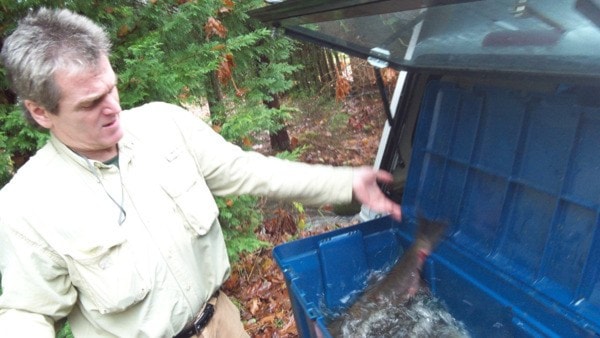With the high degree of technology that has invaded society, it’s always tougher and tougher to get kids into the great outdoors.
So the Department of Fisheries and Oceans’ have been bringing Mother Nature to them — in the classroom.
Each year students from Palsson Elementary School in Lake Cowichan raise salmon from eyed-eggs until they are old enough to be released. The project is a part of their science curriculum.
Bob Crandall is the president of the Cowichan Lake Salmonid Enhancement Society hatchery in Lake Cowichan. Crandall supplies Palsson Elementary with salmon eggs for their project.
“It’s very important to have this program because we’re teaching the children about the lifecycle of the salmon and they have an opportunity to have a hands-on experience in all parts of the salmon’s life. It’s a big part of their education,” said Crandall.
He thinks Lake Cowichan youth are extremely lucky to grow up in an area so rich in natural life.
“It’s something someone in the city can’t always do on any given day. It’s quite a full experience. A lot of people don’t get to have that kind of excitement,” he added.
In February Crandall will deliver Palsson with its latest batch of Salmon eggs. In April Palsson elementary students will release the salmon fry back into Oliver Creek in Friendship Park.
“They will release the same fish that they saw come out of the wild as eggs and go into the trays and into the classroom. It’s a complete cycle of life for the children to witness and be apart of,” described Crandall.
The salmon are kept in insulated tanks equipped with chiller systems to maintain a tank temperature similar to that of a creek, which is roughly 10 degrees Celsius. DFO will occasionally come into the school to do maintenance on these tanks.
Kim Walters has embraced the DFO salmon hatchery program in her classroom for five years. A nature and environmental enthusiast, Walters is pleased her students are able to partake in such a proactive approach to education and science in the classroom.
“Any way that I can teach the children that we have a role in the environment then I did good. I like them to see the whole life cycle and how everything is tied together. They love raising them in the classroom.
Walters indicated that being around the salmon actually improves her students behavior.
“There are never any behavioral issues when you bring in something live that they can be a part of when they release them. It is quite a big event when we release them,” she added.
Walters never ceases to be impressed with the job her students have done in hatching salmon.
“They are such devoted, wonderful stewards. It’s just amazing to see just how attached they get to them,” she described.
While in the classroom the salmon eggs must be protected from the school’s fluorescent lights and need to be covered up.
Ted Johnson is a Lake Cowichan fisherman who has helped the Lake Cowichan Salmonid Enhancement Society catch some of the Coho salmon whose eyed-eggs will be used in the classroom this coming February. He’s happy to be apart of the process and lend a helping hand, especially if it benefits some local kids.
“It’s a wonderful thing. It’s a learning process for sure. I’m proud to help them out if we can,” said Johnson, who has been fishing for roughly 40 years.
However, his years of experience aren’t all to be accounted for in his various catches for Crandall. Crandall noted that approximately 10,000 salmon passed a counting fence in the river over a 20-day period that ended on October 20.
